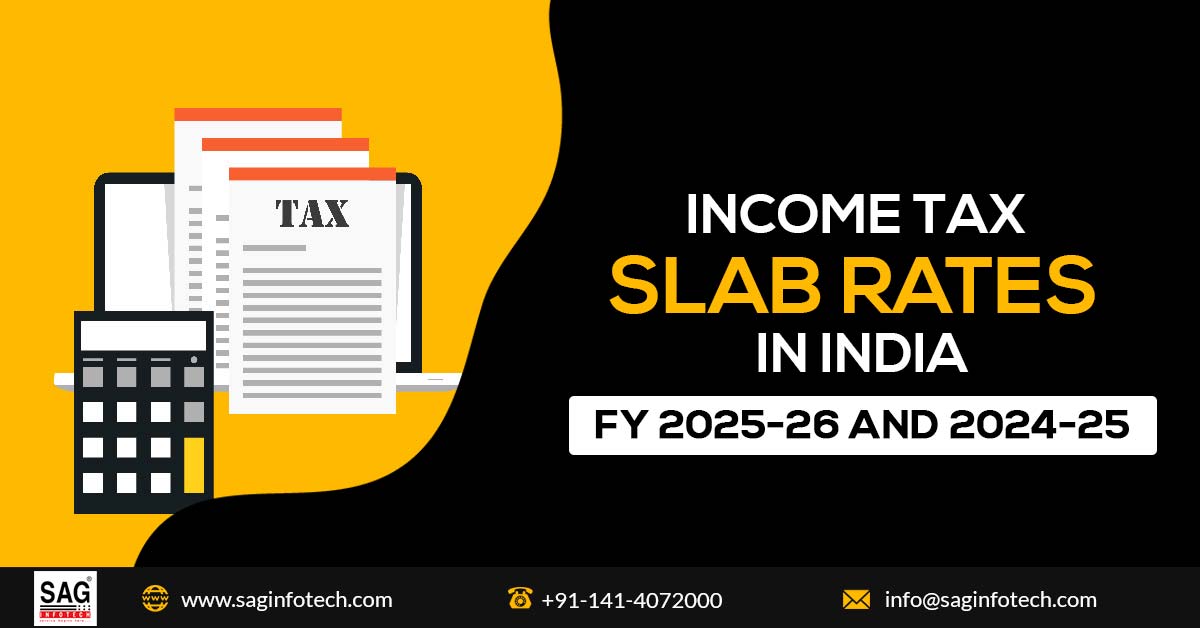
Income tax is a kind of direct tax among the two types of taxes – direct tax and Indirect Tax. Income Tax is charged by the government on the income earned by the taxpayer or any profit or revenue generated by him in a specific Fiscal Year, i.e. the year in which income is generated.
However, an assessee pays the income tax in the assessment year 2025-26, i.e. the year next to the FY 2025-26 in which the income of the taxpayer is assessed or evaluated. Provisions to deal with income tax are mentioned in the Income Tax Act of 1961. Also, SAG Infotech company is delivering income tax slab rates for FY 2025-26 and 2024-25 for taxpayers.
Submit Query for Income Tax Compliance Software
What Are the Slab Rates for Income Tax in India?
The Indian Income Tax System employs numerous income tax slabs to collect taxes from individuals and non-individuals based on their income.
Income Tax Slab Rates
- Depending on the applicable slab rate, which changes annually, the tax is applied to a range of income.
- Every year, the Finance Minister makes the income tax slab rates public in the Union Budget.
Division of Income Tax Slab Rates
- By Age (For Individual Only)
- Partnership Firms or LLPs
- Domestic Company
- Foreign Company
- Co-operative Societies
- Local Authorities
Income Tax Slab Rates Under the New Tax Regime for FY 2025-26
| Income Tax Slabs | Tax Rates (NTR) |
|---|---|
| Upto Rs.4 lakh | NIL |
| Rs. 4 lakh – Rs.8 lakh | 5% |
| Rs 8 lakh – Rs 12 lakh | 10% |
| Rs 12 lakh – Rs 16 lakh | 15% |
| Rs 16 lakh – Rs 20 lakh | 20% |
| Rs 20 lakh – Rs 24 lakh | 25% |
| Above Rs 24 lakh | 30% |
Note: The old tax regime slab rates for FY 2025-26 remain the same as those for FY 2024-25.
Income Tax Slab Rates for FY 2024-25
| Old I-T Regime for FY 2024-25 | New I-T Regime After Budget 2024 (From 1st April 2024) | |
|---|---|---|
| Range of Income | ||
| INR 0-INR 2,50,000 | – | |
| INR 2,50,000- INR 3,00,000 | 5% | – |
| INR 3,00,000- INR 5,00,000 | 5% | 5% |
| INR 5,00,000- INR 7,00,000 | 20% | 5% |
| INR 7,00,000- INR 10,00,000 | 20% | 10% |
| INR 10,00,000- INR 12,00,000 | 30% | 15% |
| INR 12,00,000- INR 15,00,000 | 30% | 20% |
| Above INR 15,00,000 | 30% | 30% |
Let’s have a look at the income tax slabs for different taxpayers for the AY 2025-26:-
Income Slab & Tax Rates (AY 2025-26) for Resident Individual Age =>60 years
| Income Slab | Income Tax |
|---|---|
| Upto Rs. 2,50,000 | NIL |
| Rs. 2,50,000 – Rs. 5,00,000 | 5% |
| Rs. 5,00,000 – Rs. 10,00,000 | 20% |
| Above Rs. 10,00,000 | 30% |
| Surcharge( subject to Marginal Relief ) | 10% (If taxable income > Rs. 50 lacs) |
| 15% (If taxable income > Rs. 1 Crore) | |
| 25% (If taxable income > Rs. 2 Crore) | |
| 37% (If taxable income > Rs. 5 Crore) | |
| Health & Education Cess | 4% of(Income Tax + Surcharge) |
Surcharge
Note: The same income tax slab & rates are applicable to any Non-Resident Individual (NRI), Hindu Undivided Family (HUF), Association Of Persons (AOP), Body Of Individuals (BOI) and Artificial Juridical Person (AJP).
Now, we are coming on to an income tax slab & rates are applicable on Senior Citizens for FY 2024-25, i.e. the citizens who are above 60 years of age but below 80 years of age. (Under Old Regime)
Recommended: Calculate your Taxable Income with the Free Income Tax Calculator
Income Slab & Tax Rates for Senior Citizens (FY 2024-25 & AY 2025-26)
| Income Slab | Income Tax |
|---|---|
| Upto Rs. 3,00,000 | NIL |
| Rs. 3,00,000 – Rs. 5,00,000 | 5% |
| Rs. 5,00,000 – Rs. 10,00,000 | 20% |
| Above Rs. 10,00,000 | 30% |
| Surcharge( subject to Marginal Relief ) | 10% (If taxable income > Rs. 50 lacs) |
| 15% (If taxable income > Rs. 1 Crore) | |
| 25% (If taxable income > Rs. 2 Crore) | |
| 37% (If taxable income > Rs. 5 Crore) | |
| Health & Education Cess | 4% of (Income Tax + Surcharge) |
Income Tax slab & rates for the very senior citizens FY 2024-25, i.e. the citizens of age 80 years or above, is showcased in a below-given table below, in which the tax exemption limit of income extends to Rs. 5,000,000. Here we go.
Income Slab & Tax Rates (AY 2025-26) for Income of Super Senior Citizens
| Income Slab | Income Tax |
|---|---|
| Upto Rs. 5,00,000 | NIL |
| Rs. 5,00,000 – Rs. 10,00,000 | 20% |
| Above Rs. 10,00,000 | 30% |
| Surcharge( subject to Marginal Relief ) | 10% (If taxable income > Rs. 50 lacs) |
| 15% (If taxable income > Rs. 1 Crore) | |
| 25% (If taxable income > Rs. 2 Crore) | |
| 37% (If taxable income > Rs. 5 Crore) | |
| Health & Education Cess | 4% of (Income Tax + Surcharge) |
Note: Rebate for individuals with income below Rs 5,00,000 u/s 87A. The rebate is Rs 12,500 or 100% of income tax (whichever is lesser).
Now, we shall discuss the different Income Tax slabs & tax rates applicable to the income of Firms, Cooperative Societies, Local Authorities and Companies.
Income Tax Slab & Rates Applicable on Cooperative Society
| Income Slab | Income Tax |
|---|---|
| Upto Rs. 10,000 | 10% |
| Rs. 10,000 – Rs. 20,000 | 20% |
| Above Rs. 20,000 | 30% |
| Surcharge( subject to Marginal Relief ) | 12% (If taxable income > Rs. 1 Crore) |
| Health & Education Cess | 4% of (Income Tax + Surcharge) |
Income Tax Slab & Rates Applicable to the Firm
| Particular | Income Tax |
|---|---|
| Income Tax | 30% |
| Surcharge( subject to Marginal Relief ) | 12% (If taxable income > Rs. 1 Crore) |
| Health & Education Cess | 4% of (Income Tax + Surcharge) |
Income Tax Slab & Rates Applicable on Local Authority
| Particular | Income Tax |
|---|---|
| Income Tax | 30% |
| Surcharge( subject to Marginal Relief ) | 12% (If taxable income > Rs. 1 Crore) |
| Health & Education Cess | 4% of (Income Tax + Surcharge) |
Income Tax Slab & Rates Applicable to Different Companies
For the Domestic Company, which is claiming exemptions and whose turnover in FY 2020-21 was up to Rs. 400 crores, the new income tax rates and slabs are as follows:
| Particular | Income Tax |
|---|---|
| Income Tax | 25% |
| Surcharge( subject to Marginal Relief ) | 7% (Taxable income above ₹ 1 crore– Up to ₹ 10 crore) |
| 12% (If taxable income > Rs. 10 Crore) | |
| Health & Education Cess | 4% of (Income Tax + Surcharge) |
For the Domestic Company, which is claiming exemptions and whose turnover in FY 2020-21 was more than Rs. 400 crores, the new income tax slabs and rates for FY 2024-25 are as follows:
| Particular | Income Tax |
|---|---|
| Income Tax | 30% |
| Surcharge( subject to Marginal Relief ) | 7% (Taxable income above ₹ 1 crore– Up to ₹ 10 crore) |
| 12% (If taxable income > Rs. 10 Crore) | |
| Health & Education Cess | 4% of (Income Tax + Surcharge) |
For the Domestic Manufacturing Company, which is not claiming exemptions (under section 115BAA), the income tax slabs and rates are as follows:
| Particular | Income Tax |
|---|---|
| Income Tax | 22% |
| Surcharge | 10% |
| Health & Education Cess | 4% of (Income Tax + Surcharge) |
For the Domestic Manufacturing Company, which is a NEW company (under section 115BAB), the income tax slabs and rates for FY 2023-24 are as follows:
| Particular | Income Tax |
|---|---|
| Income Tax | 15% |
| Surcharge | 10% |
| Health & Education Cess | 4% of (Income Tax + Surcharge) |
Income Tax Slab & Rates Applicable to Foreign Company
| Particular | Income Tax |
|---|---|
| Royalty received from Government or an Indian concern in pursuance of an agreement made with the Indian concern after March 31, 1961, but before April 1, 1976, or fees for rendering technical services in pursuance of an agreement made after February 29, 1964 but before April 1, 1976 and where such agreement has, in either case, been approved by the Central Government | 50% |
| Any other income | 40% |
| Surcharge | 2% (Iftaxable income >Rs. 1 Crore) |
| 5% (If taxable income > Rs. 10 Crore) | |
| Health & Education Cess | 4% of (Income Tax + Surcharge). |
Essential Information About New & Old Tax Regimes
- Under the new tax system, the tax rates are identical for all individual tax brackets.
- Citizens who are elderly or extremely elderly will not benefit from a higher basic exemption level under the New Tax framework.
- In both the new and the old/existing tax regimes, individuals with net taxable income of up to Rs 5 lakh and Rs 7 lakh, respectively, will be qualified for a tax rebate under Section 87A.
- Regardless of age, the baseline exemption threshold for NRIs is Rs. 2.5 Lakh.
- In every situation, an additional 4% Health and Education Cess will be added to the income tax obligation.
- Surcharges are applied for all of the aforementioned categories at the tax rates listed below:
- 10% of income tax if the total income is more than Rs. 50 lakh
- 15% of income tax if the total income is more than Rs. 1 crore
- 25% of income tax if the total income is more than Rs. 2 crore
- 37% of income tax if the total income is more than Rs. 5 crore
- In the Budget 2023, the surcharge rate of 37%, which was the highest has now been reduced to 25% under the new tax system, which will be applicable from 1st April 2023.
Surcharge and Marginal Relief on it
An income Tax Surcharge refers to an additional charge or added tax that is payable on income tax by the individual having a higher income inflow during a particular fiscal year.
Marginal Relief on Surcharge
The taxpayer has to pay a surcharge on income tax at applicable rates when his taxable income is more than Rs. 50,00,000 or Rs. 100,00,000. However, the surcharge is reduced when the increase in ‘Income Tax + Surcharge’ > the increased income over Rs. 50,00,000 or Rs. 100,00,000.
‘Surcharge’ is reduced to a limit which will result in ‘Income Tax + Surcharge’ = increase in ‘Total Taxable Income’ over Rs. 50,00,000 or Rs. 100,00,000. The amount so lessened from ‘Surcharge’ is known as ‘Marginal Relief on Surcharge’.
Section 115BAA – New Section that lowers the tax rate for Domestic Companies
Section 115BAA is a New Section which was added w.e.f. A.Y 2020-21. This section offers an option for domestic companies to pay lower taxes at 22 %. This tax rate of 22% will become 25.168% under section 115BAA after adding a 10% surcharge and a 4% cess. The computation of income under this option is subject to the following conditions:
- Exemption/deduction under the below-mentioned sections is not claimed.
- 10AA [SEZ units]
- 32(1)(iia) [additional depreciation qua new plant and machinery @ 20%/ 30%]
- 32AD [15% on new assets in undertaking set up in the mentioned backward areas of Andhra Pradesh, Bihar, Telangana, and West Bengal]
- 33AB [prescribed %age of amounts deposited with Tea/ Coffee/ Rubber Board]
- 33ABA [prescribed %age of amounts deposited in Site Restoration Account]
- 35(1)(ii)/(iia), 35(2AA) [prescribed deduction for scientific research]
- 35AD [expenditure on prescribed business]
- 35CCC [expenditure on agricultural extension project]
- 35CCD [expenditure on skill development project]
- Under Part C of Chapter VIA, other than sec- 80JJAA of the I-T Act (like 80IA/ IB/ IC/ ID/ IE & so on)
- Carry-forward losses are not settled off to the limit that the loss relates to deductions specified above. These losses also would not be permitted to be carried forward to subsequent years.
- Depreciation except for the additional depreciation u/s 32(1)(iia) is duly claimed.
Section 115BAB – New Section that lowers the tax rate for Domestic Manufacturing Companies
Section 115BAB is a New Section which was added w.e.f. A.Y 2020-21. This section offers an option for domestic manufacturing companies to pay lower taxes at 15 %. This tax rate will also include a 0% surcharge and a 4% cess. The availability of the option is subject to the condition that the company is established and registered on or after 1st October 2019 and starts manufacturing operations by or before 31st March 2023.
- Alike section 115BAA provisions, income for the above-mentioned lower rate has to be calculated without claiming exemptions & deductions and setting off the losses which have been brought forward.
- Besides, the company shall not be allowed to subsequently drop out of the option if any of the options available under sections 115BAB & 115BAA are chosen by it.
Additional requirements for the execution of this option are as follows:
- The company must not be found by dividing or reconstructing the business which is in existence already.
- The company must not use a building hitherto used as a convention centre or hotel.
- The company must not use the plant or machinery used earlier for any purpose. However, the used plant and machinery can be reused to the limit of 20% of the total value of the plant and machinery.
Section 115JB – Recent amendments that lower down MAT on book profit for companies not opting for the beneficial option u/s 115BAA/ 115BAB
Amendments have been made in the provisions of section 115JB to bring down the Minimum Alternate Tax (MAT) on book profit. MAT shall be reduced to 15% from 18.5% w.e.f. The assessment year 2020-21.
Note: Companies opting for the lower tax option u/s 115BAA/ 115BAB are exempted from MAT on book profit u/s 115JB.
So these are categories of the taxpayer defined by the income tax department if a taxpayer belongs to any one of these categories, then he/she has to pay the income tax because it is mandatory.
Online filing of income tax returns is quite an easy process with available tools and software. SAG Infotech company also provides an Income Tax E-Filing solution to upload returns directly from the software, named the Gen Income Tax Return Filing software.



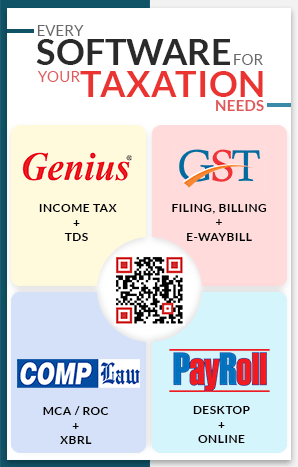

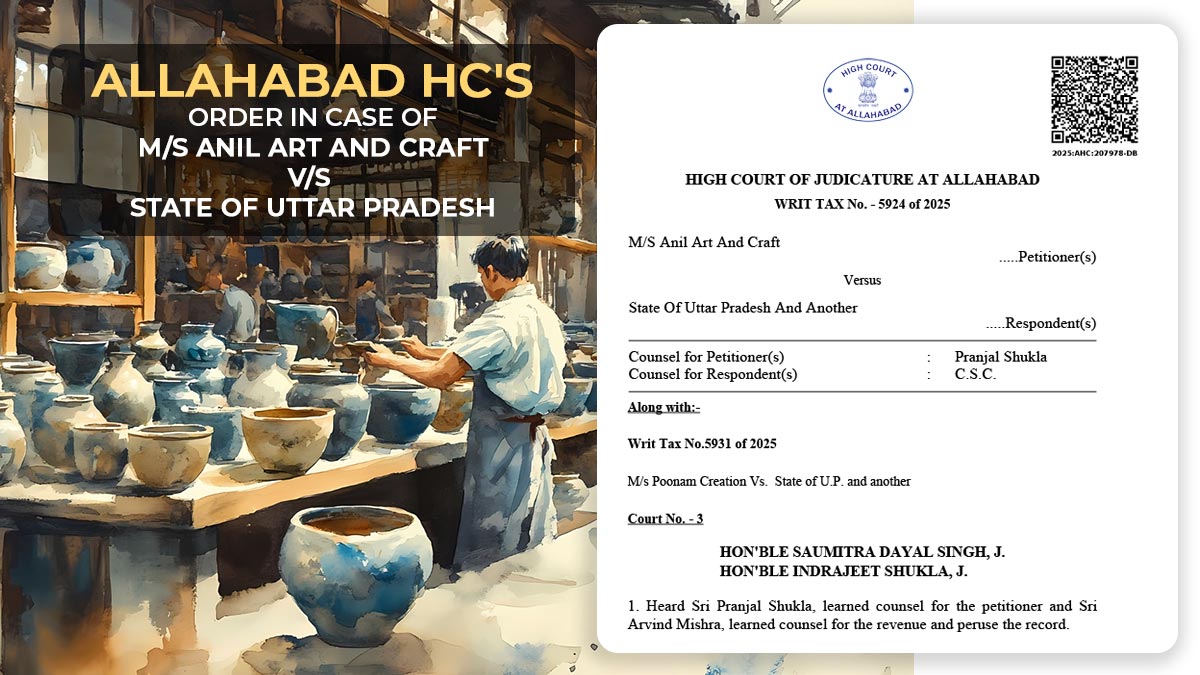

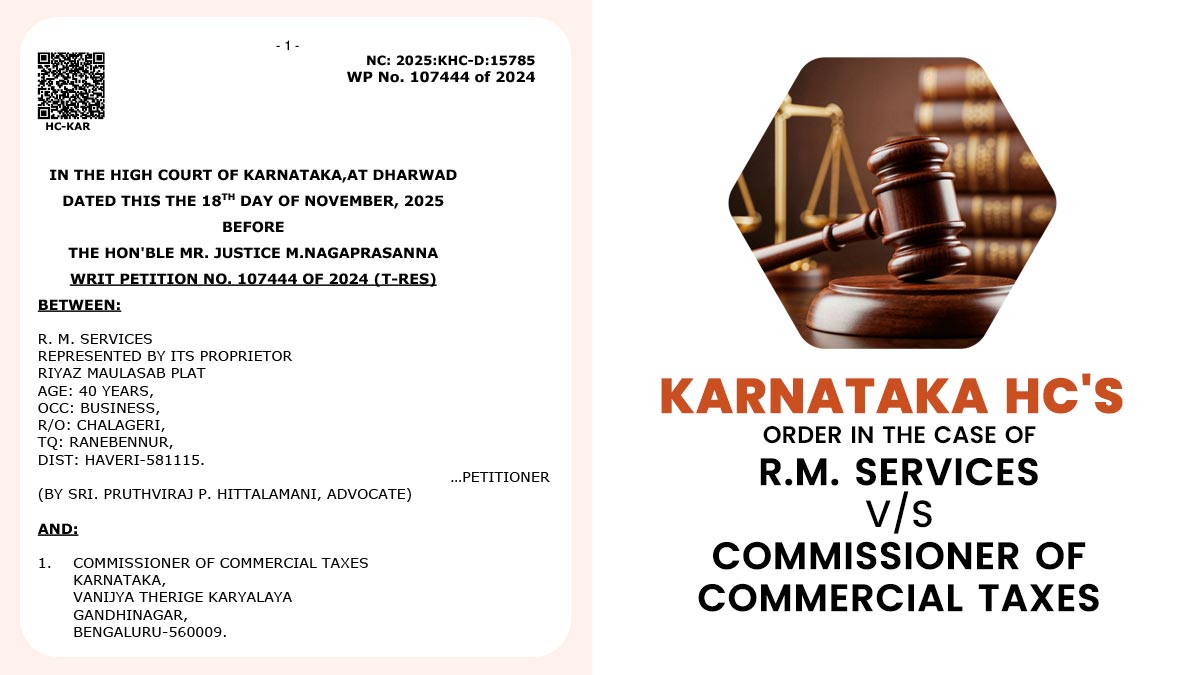
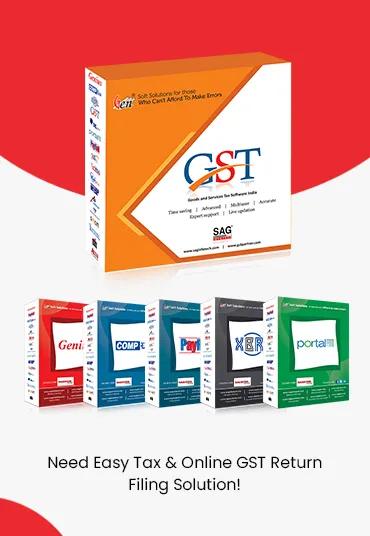

What is the Rate of Depreciation on LABORATORY EQUIPMENT used in Testing of Materials manufacture in factory / for quality control
Sir, I am a sr. citizen and filing our return regularly. Last year we got PR from Canada Govt which my daughter had sponsored. I lived there for about 5 months and cam back to India. I am not interested to go there further. In Canada, I supported my daughter for her professional work and she paid me total of about 15000 Canadian Dollars as a professional fee for that. She also filed our Income-tax return in Canada and no tax was levied on this income.
I want to declare this 15000 CAD in my return which I am going to file for the FY 2019-20.
Should I add this amount (in Indian rupees converted) in my interest income earned in India and pay tax? Can I file ITR 1? I don’t have any other income except about Rs.3.00 lacs as bank interest.
Please guide me. Regards.
Kindly correct your write-up/Article… It is miss-guiding to the people…..
For instance, If you will opt section 115JAA of the Income-tax Act, 1961, 10% Surcharge shall be levied on Income tax amount irrespective of total Income…
But you people had mentioned that “if you will opt 115JAA option, the surcharge will be applicable if your income exceeds 1 Crore…. that is totally incorrect.
Kindly refer Finance Acts-2019 (No. 2) for more details/clarity
1[Provided also that in case of every domestic company whose income is chargeable to tax under section 115BAA or section 115BAB of the Income-tax Act, the advance tax computed under the first proviso shall be increased by a surcharge, for the purposes of the Union, calculated at the rate of ten percent of such “advance tax”.]
There is no reference of section 115JAA in the article.
Hello, i am security researcher (website security)..also college student
i earn from bounty (mainly by IT companies like google facebook etc) approx 8 lac i earn from july 2016 to april 2017
how much i have to pay and last date of submission
please guide me
Income Tax Rate Slab for AY 2017-18 :
As you have mention that your income is Rs. 8 lakhs, tax amount payable shall be Rs. 85000 plus 3% education and secondary-and-higher-education-cess i.e. Rs.2550/-. Therefore Total Tax liability will be Rs.87550/-.
Due date of filling of return for AY 2017-18 is 31.07.2017.
I am Senior citizen . my income is from pension and bank interest. For f.y. 2016_17 a.y 2017_18 what is the date upto which tax can e paid.
Dear sir,
What is last date of filling declaration. additionally last date of e-filing.
Regards
Dinesh
Can you please explain more?
Sir, I am filling 2020-2021 income tax return but not receive my acknowledgment
You can download your acknowledgement by logging in to efiling portal through your id and password and then download it from efilled returns/forms.
I am a pensioner. What will be the extent of deduction admissible to me u/s 80gg. How do I submit my rent receipt i.e.12 months separate receipts or a single stamped receipt from my house owner for 12 months ? 2. What is the extent of tax rebate admissible if my income is below 5 lakhs ? This is for the FY 2016 – 2017 &AY 2017 – 2018.
Deduction under section 80GG shall be allowed as lower of the following:
1) Rent paid less 10% of Total Income.
2) 25% of Total Income.
3) 2000 per month.
Rebate under section 87A is Rs 5000 if Total Income is upto Rs. 5Lakhs for AY 2017-18.
Sir,
Is there any changes in the Excise duty rate, & service Tax Rate for the A.Y 2017-18 Income Tax return Filing?
No, there is no changes in rates.
I am a sr. citizen having income from monthly pension and interest only. For the FY 2016-17, by what date I am to deposit Income Tax?
If your tax liability is more than 10000 rs then there is advance tax liability will be generated on your part and there is 4 advance tax payments dates. If your tax liability is lower than 10000 rs in that situation the due date of payment of tax is 31 March.
Due date extended for audit firms 17 th oct-2016. By cbdt. Its unjustified while half country facing flood, rain till date and some suffuring from highly sensitive desease i. e. Mahamari etc. Thats not justice.
am an individual having only fixed deposit interest and i have collected my papers from auditor and want to file directly through online. I have paid advance tax for the AY 17 – 18. Auditor usually paying tax every year march 31st for previous year that is FY 15 – 16. But after gathering information from all the website now came to know non-audit case and audit case. Now what can i do already sep ‘ 16 has gone 17th oct 16 is last date for audit case. shall approach new auditor for this year ? please advise i am having only simple income only from fixed deposits.
If you have Income only from Interest that means as a individual you are not covered under audit. In that case you can file your return without Audit.
is the last date for tax efiling is extended till aug 31 2016 – please advise
No, The date is 31st July, 2016
what is the due date for filling return for financial year 2016-17
For the companies and the person liable for audit, due date is 30th September 2016 and others 31st July, 2016
Is it for F.Y 2015-16, which is you told us or F.y 2016-17, because questioner asked you about f.y 2016-17.
should i file it returns for year 2016-17 by which date because i had it returns for the year 2015-16 only in the month of march 2016
for f.y. 2015-16 due date is 31/7/2016. You can late file your return till 31/3/2017. In that case, if you have tax liability then interest should be applicable on you.
what is the maximum limit to invest in Senior Citizen scheme Post Office @ 9.3% interest per annum
I am spending more than 70000 rupees for my illness, Myasthenia Gravis by way of Medicines and Doctor fees and lab. charges for the last 3 years. Am I eligible for It Rebate. I am a senior Citizen.
I understand Dividends are tax free. Please comment.
Yes, Dividends are tax free.
YES.. They are tax free because they are considered in heads of income from other source as tax free dividends.
Tax Rates for Females / Ladies are not given… Kindly update it…
Regards
AltafUllah
Hello Altaf, there is no such gender difference in indian income tax department. Income tax rates is same for female as well as male.